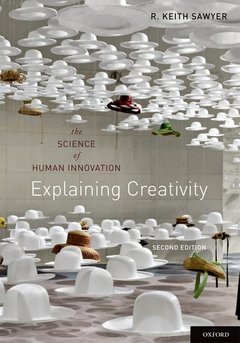Explaining Creativity (2nd Ed.) The Science of Human Innovation
Langue : Anglais
Auteur : Sawyer R. Keith

Explaining Creativity is an accessible introduction to the latest scientific research on creativity. The book summarizes and integrates a broad range of research in psychology and related scientific fields. In the last 40 years, psychologists, anthropologists, and sociologists have devoted increased attention to creativity; we now know more about creativity than at any point in history. Explaining Creativity considers not only arts like painting and writing, but also science, stage performance, business innovation, and creativity in everyday life. Sawyer's approach is interdisciplinary. In addition to examining psychological studies on creativity, he draws on anthropologists' research on creativity in non-Western cultures, sociologists' research on the situations, contexts, and networks of creative activity, and cognitive neuroscientists' studies of the brain. He moves beyond the individual to consider the social and cultural contexts of creativity, including the role of collaboration in the creative process.
Part I: Conceptions. Chapter 1: Introduction. Chapter 2: Conceptions of Creativity. Part II: Individualist Approaches. Chapter 3: Defining creativity through assessment. Chapter 4: The creative personality. Chapter 5: The creative process, part 1. Chapter 6: The creative process, part 2. Chapter 7: The creative process, part 3. Chapter 8: Computer simulations of the creative process. Chapter 9: Biology and creativity. Chapter 10: Cognitive neuroscience and creativity. Part III: Sociocultural Approaches. Chapter 11: Sociology. Chapter 12: Group creativity. Chapter 13: Organizational creativity. Chapter 14: Culture and creativity. Chapter 15: History and creativity. Part IV: Creativity in the Domains. Chapter 16: Visual Arts. Chapter 17: Writing. Chapter 18: Music. Chapter 19: Theater. Chapter 20: Science. Part V: Everyday Creativity. Chapter 21: Education and creativity. Chapter 22: How to be more creative. Chapter 23: Conclusion: The future of creativity. Appendices. The domain of creativity research. Appendix A: Creativity timeline. Appendix B: Creativity overviews. Appendix C: Journals that publish creativity research. Appendix D: Influential books in creativity research. Appendix E: Journal special issues. The field of creativity research. Appendix F: Important creativity researchers. Appendix G: Colleges and universities with a degree or certificate in creativity. Appendix H: Professional associations and conferences. References.
R. Keith Sawyer, a professor of psychology, education, and business at Washington University in St. Louis, is one of the world's leading scientific experts on creativity. He combines this scientific expertise with a strong hands-on background in real-world creativity. After receiving his computer science degree from MIT in 1982, he began his career with a two-year stint designing videogames for Atari. In 1990, Dr. Sawyer began his doctoral studies in psychology, studying creativity with Dr. Mihaly Csikszentmihalyi. Dr. Sawyer has also been a jazz pianist for over 20 years, and spent several years playing piano with Chicago improv theater groups.
Date de parution : 01-2012
Ouvrage de 568 p.
25.1x17.5 cm
Thèmes d’Explaining Creativity :
© 2024 LAVOISIER S.A.S.



